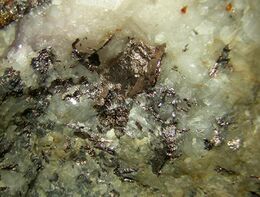Chemistry:Breithauptite
From HandWiki
Short description: Nickel antimonide mineral
| Breithauptite | |
|---|---|
 Breithauptite on calcite from the Samson Mine, St Andreasberg, Harz Mountains, Lower Saxony, Germany (Field of view 17 mm) | |
| General | |
| Category | Antimonide mineral |
| Formula (repeating unit) | nickel antimonide (NiSb) |
| Strunz classification | 2.CC.05 |
| Crystal system | Hexagonal |
| Crystal class | Dihexagonal dipyramidal (6/mmm) H-M symbol: (6/m 2/m 2/m) |
| Space group | P63/mmc |
| Unit cell | a = 3.946 Å, c = 5.148 Å, Z = 2 |
| Identification | |
| Color | Pale copper-red, may be with violet tint |
| Crystal habit | Crystals rare, thin tabular or needlelike, to 1 mm; arborescent, disseminated, massive |
| Twinning | Twin plane {1011} |
| Cleavage | None |
| Fracture | Subconchoidal to uneven |
| Tenacity | Brittle |
| Mohs scale hardness | 5.5 |
| |re|er}} | Metallic |
| Streak | Reddish brown |
| Diaphaneity | Opaque |
| Specific gravity | 7.591–8.23 measured; 8.629 calculated |
| Pleochroism | Very distinct |
| References | [1][2][3] |
Breithauptite is a nickel antimonide mineral with the simple formula NiSb. Breithauptite is a metallic opaque copper-red mineral crystallizing in the hexagonal - dihexagonal dipyramidal crystal system. It is typically massive to reniform in habit, but is observed as tabular crystals. It has a Mohs hardness of 3.5 to 4 and a specific gravity of 8.23.
It occurs in hydrothermal calcite veins associated with cobalt–nickel–silver ores.

Massive breithauptite with orange-brown nickeline and minor quartz from the Cobalt area of Ontario, Canada
It was first described in 1840 from the Harz Mountains, Lower Saxony, Germany , and in 1845 for occurrences in the Cobalt and Thunder Bay districts of Ontario, Canada . It was named to honor Saxon mineralogist Johann Friedrich August Breithaupt (1791–1873).
See also
References
- ↑ Handbook of Mineralogy
- ↑ Mindat with location data
- ↑ Webmineral data
- ↑ Warr, L.N. (2021). "IMA–CNMNC approved mineral symbols". Mineralogical Magazine 85 (3): 291–320. doi:10.1180/mgm.2021.43. Bibcode: 2021MinM...85..291W. https://www.cambridge.org/core/journals/mineralogical-magazine/article/imacnmnc-approved-mineral-symbols/62311F45ED37831D78603C6E6B25EE0A.
- Palache, C., H. Berman, and C. Frondel (1944) Dana's system of mineralogy, (7th edition), v. I, pp. 238–239
 |

